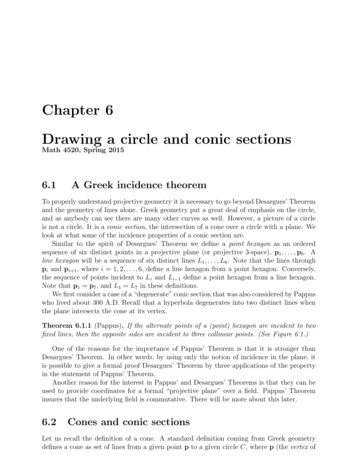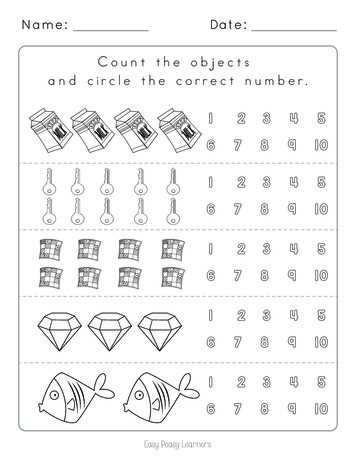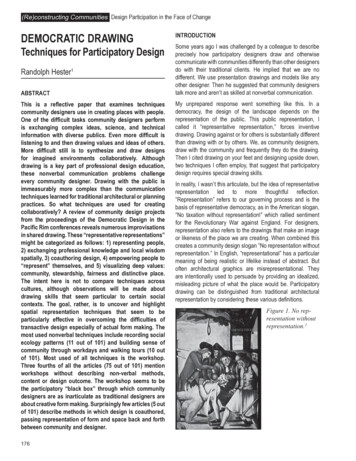
Transcription
Chapter 6Drawing a circle and conic sectionsMath 4520, Spring 20156.1A Greek incidence theoremTo properly understand projective geometry it is necessary to go beyond Desargues’ Theoremand the geometry of lines alone. Greek geometry put a great deal of emphasis on the circle,and as anybody can see there are many other curves as well. However, a picture of a circleis not a circle. It is a conic section, the intersection of a cone over a circle with a plane. Welook at what some of the incidence properties of a conic section are.Similar to the spirit of Desargues’ Theorem we define a point hexagon as an orderedsequence of six distinct points in a projective plane (or projective 3-space), p1 , . . . , p6 . Aline hexagon will be a sequence of six distinct lines L1 , . . . , L6 . Note that the lines throughpi and pi 1 , where i 1, 2, . . . , 6, define a line hexagon from a point hexagon. Conversely,the sequence of points incident to Li and Li 1 define a point hexagon from a line hexagon.Note that p1 p7 , and L1 L7 in these definitions.We first consider a case of a “degenerate” conic section that was also considered by Pappuswho lived about 300 A.D. Recall that a hyperbola degenerates into two distinct lines whenthe plane intersects the cone at its vertex.Theorem 6.1.1 (Pappus). If the alternate points of a (point) hexagon are incident to twofixed lines, then the opposite sides are incident to three collinear points. (See Figure 6.1.)One of the reasons for the importance of Pappus’ Theorem is that it is stronger thanDesargues’ Theorem. In other words, by using only the notion of incidence in the plane, itis possible to give a formal proof Desargues’ Theorem by three applications of the propertyin the statement of Pappus’ Theorem.Another reason for the interest in Pappus’ and Desargues’ Theorems is that they can beused to provide coordinates for a formal “projective plane” over a field. Pappus’ Theoreminsures that the underlying field is commutative. There will be more about this later.6.2Cones and conic sectionsLet us recall the definition of a cone. A standard definition coming from Greek geometrydefines a cone as set of lines from a given point p to a given circle C, where p (the vertex of
2CHAPTER 6. DRAWING A CIRCLE AND CONIC SECTIONSMATH 4520, SPRING 2015pp31CLASSICAL2p5GEOMETRIESOne of the reasons for the importance of Pappus' Theorem is that it is stronger thanDesargues'Theorem. In other words, by using only the notion of incidence in the plane, itis possible to give a formal proof Desargues' Theorem by three applications of the propertyin the statement of Pappus' Theorem.p interest in Pappus' and Desargues' Theorems is that they can beAnother reason for the4pp over a field. Pappus'Theoremused to provide coordinates for a formal "projectiveplane"62insures that the underlying field is commutative. There will be more about this later .Figure 6.17.2ConesandconicsectionsLet us recall the definition of a cone. A standard definition coming from Greek geometrydefines a cone as set of lines from a given point p to a given circle C, where p ( the vertexof theoncone)on perpendicularthe line perpendicularto theplaneplane ofC throughthe centerthe cone) liesthelieslineto theof thethecirclecircleC throughthe center of C,of C Tbut not in the plane. This is called a right circular cone. The intersection of a planebut not in".jththesuchplane.This is called a right circular cone. The intersection of a plane witha right circular cone is the geometric definition of a conic section. See Figuresuch a rightcircularconeis the geometric definition of a conic section. See Figure 6.2.7.2.1.Figure 6.2It turns out that it is not necessary for the cone to be a right circular cone. Any cone overa conic section ( where the vertex of the cone is not necessarily on the line perpendicular tothe plane through the "center" of the conic section), when intersected by a plane is againsection.it is not necessary for the cone to be a right circular cone. Any coneIt turnsa conicout thatLooking at things as an artist, this says that any drawing of a conic section is again aover a conicconicsection(where the vertex of the cone is not necessarily on the line perpendicularsection. The picture plane is the intersecting plane. With this in mind we give anto the planethroughthe “center”of theinconicsection),whenintersectedby a plane is againalgebraic definitionof a conic sectionthe Euclideanplanewith Cartesiancoordinates.a conic section.Looking at things as an artist, this says that any drawing of a conic section is again aconic section. The picture plane is the intersecting plane. With this in mind we give analgebraic definition of a conic section in the Euclidean plane with Cartesian coordinates. Wesay that a conic section is any set S of the formS {(x, y) Ax2 Bxy Cy 2 Dx Ey F 0},where A, . . . , F are constants.
6.3. INCIDENCE PROPERTIES OF CONICS, PAPPUS’ AND PASCAL’S THEOREMS3CIRCLE,CONICSECTIONS3If S is empty, one point, one DRAWINGline, orAtwolines,thenwe say that S is degenerate.Otherwisewe say S is ranellipse,parabola,We say that a conic section is any set S of the formhyperbola, or circle. If we wish, we can regard S as a subset of the (points of the) projectiveAx2 Bxy Cy2 Dx Ey F 0},plane and the parabola and hyperbola are distinguished by their having one or two points,whereA, .,F arerespectively, onthelineatconstants.infinity. For a parabola, the equivalence class of lines parallelIf S is empty, one point, one line, or two lines, then we say that S is degenerate.to the axis of Otherwisesymmetryto Notea pointat infinity conicthatis eitherlies onthe parabola. For awe saycorrespondsS is non-degenerate.that a non-degeneratean ellipse,hyperbola, or circle.If weofwishwe canregard Stoas athesubsetof the(points ofhyperbola, theparabola,two pond tothe) projective plane and the parabola and hyperbola are distinguished by their havingtwo points at oneinfinitythat lieon the onhyperbola.or two points,respectively,the line at infinity. For a parabola, the equivalenceclassoflinesparalleltothe axisof symmetry andcorrespondsto a point at definitioninfinity that liesIt turns out that the algebraicdefinitionthe geometricof a conic sectionon the parabola. For a hyperbola, the two equivalence classes of lines parallel to the twoare equivalent,as rmptotesand toanotherplane is a conicto two points that lie on the hyperbola at egeometricdefinitionofaconicsectionsection in the other plane. For instance, if one looks at a parabola receding off to infinity,are equi'\'alent, and the projection of conic section from one plane to another plane is athen a pictureconicof sectionthis willellipsetangenttolookstheathorizonthe pictureplane. Notein the beotheranplane.For instance,if onea parabola inrecedingoff toinfinity,then a pictureof this willonbe thean ellipsetangentto the thanhorizon onein themightpicture plane.that this impliesanothersymmetryconicsectionnot first realize. SeeNote that this implies another s)rmmetry on the conic section than one might first realize.Figure 6.3See Figure 7.2.2.s {(x,y)Figure 6.3The previous defmition of a conic is more accurately called a point conic, since it is aset of points. A dual notion is a line conic which consistsof the collection of lines tangentto a non-degeneratepoint conic. For instan.ce,if the line conic is a parabola, the line atinfinityis the only linethe line isconic.Noteaccuratelytp, t a line is tangentif andonly since it is a setThe previousdefinitionof aonconicmorecalledto aa conicpointconic,if the line intersects the (point) conic at exactly one point. Note that this definition ofpoints. A dualnotionis gooda lineconicwhichconsistsof thetangencyis not sofor othercurves,of course.SeeFigure7.2.3.collection of lines tangent to aofnon-degenerate point conic. For instance, if the line conic is a parabola, the line at infinityis on the line conic. The other line conics do not have the line at infinity. Note that a lineis tangent to a conic if and only if the line intersects the (point) conic at exactly one point.Note that this definition of tangency is not so good for other curves, of course. See Figure6.4.6.3Incidence properties of conics, Pappus’ and Pascal’s TheoremsThe “generalization” of Pappus Theorem to include the case of a non-degenerate conic wasfirst discovered by a sixteen-year-old boy in the the seventeenth century.Theorem 6.3.1 (Blaise Pascal, 1640)). If a point hexagon lies on a point conic, then thethree pairs of opposite sides are incident to three collinear points. See Figure 6.5.Much later in the nineteenth century the “dual” statement of Pascal’s Theorem wasdiscovered.
Figure7.2.34CLASSICAL GEOMETRIES4CHAPTER6. DRAWING A CIRCLEAND CONIC SECTIONSMATH 4520, SPRING 20157.3 Incidence propertiesof conics, Pappus' and Pascal's TheoremsThe "generalization" of Pappus Theorem to include the caseof a non-degenerateconicwas first discoveredby sixteen-year-old boy in the the seventeenthcentury.Theorem {Blaise Pascal, 1640). H a point hexagon lies on a point conic, then thethree pairs of opposite sides are incident to three collinear points. SeeFigure 7.3.1.Figure7.2.3Figure 6.47.3 Incidence propertiesof conics, Pappus' and Pascal's TheoremsThe "generalization" of Pappus Theorem to include the caseof a non-degenerateconicwas first discoveredby sixteen-year-old boy in the the seventeenthcentury.Theorem {Blaise Pascal, 1640). H a point hexagon lies on a point conic, then thethree pairs of opposite sides are incident to three collinear points. SeeFigure 7.3.1.Figure 7.3.1Figure 6.5Much laterin thecenturythe eenth(C. J. Brianchon1806)).a line hexagonlies onofa lineconic, thentheFigure If7.3.1discovered.three lines, through opposite points of the hexagon, are incident with a point. See Figure 6.6.Theorem (C.J. weBrianchon1806).a,linehexagonon a lineconic,the ��sliesTheoremandBrianchon’sTheMuchlaterin thenineteenthcenturythe "dual"statementofPascal'sTheoremwasthenoremcanbe used pointsto find arbitrarilymany pointslines) onwitha coniconce fiveSeepoints(or 7.3.2.discovered.lines, throughoppositeof the hexagon,a,'e(orincidenta point.Figurelines)are known.fact, five pointsa conicthat thethereis one andTheorem(C. J.InBrianchon1806). “determine”H a,line hexagonlies onina theline senseconic, hat or lines).Thiscanthroughoppositepointsof thehexagon,a,'e incidenta inition of a conic,since(oreachpoint ondeterminesoneequationTheorem e pointsBeforewe prove thesetheorems we manyobserve thatPascal's knownisredundant,sincemultiplicationbyaconstantcan Inbe usedfind arbitrarilypoints (or lines)on a coniconcesensefive points( or lines) areTheoremknown.fact,to fivepoints many"determine"a conicin thethat there is onedoes( ornotchangethe setthe equationis a0.conicNotethatsensethethatconicthroughlines)are known.In S,fact,wherefive points"determine"in thethereis one the fiveand only pointsoneconicthroughfivedistinctnon-collinear (non-copunctal) points (or lines).degeneratetotwolines.andcouldonly oneconic throughfivedistinct non-collinear (non-copunctal) points (or lines).This can alsobecanseenfromthedefinitionofa conic,sinceeachpointdeterminesThisalsoseenfrom algebraicthedefinitionconic,sinceeachpoint ofdeterminesSupposethatbefivepointson aalgebraicconic areknownofasainFigure6.7.Thinkthesefive pointsp1 , . . . , p5 as part of a point hexagon. Draw an arbitrary line through p1 and regard it asthe other line of the hexagon through p1 . We can then find two of the three points of theintersections of opposite sides. The line through those two points intersects the line throughp2 and p3 , which by Pascal’s Theorem must be the third intersection of the opposite sides.The line through p5 and this point determine the last line of the hexagon and thus the pointp6 on the conic. See Figure 6.7. Just as in the case with Desargues’ Theorem we cannotprove Pascal’s Theorem by only using the axioms of a projective plane. We need to knowsomething more, and even just having our plane sitting in a projective three-space is not
quation and there six unknowns. One unknown is redundant, since multiplicationtant does not change the set 5, where the equation is 0. Note that the conic throuCIRCLE, CONIC SECTIONS5e points could degenerateDRAWINGto two Alines.6.3. INCIDENCE PROPERTIES OF CONICS, PAPPUS’ AND PASCAL’S THEOREMS5ppose that five points on a conic are known as in Figure 7.3.3. Think of thesePI, ., Ps as part of a point hexagon. Draw an arbitrary line through PI and reghe other line of the hexagon through PI. We can then find two of the three pointersections of opposite sides. The line through those two points intersectsrough P2 and P3, which by Pascal's Theorem must be the third intersection ofte sides. The line through Ps and this point determines the last line of the hexaus the point P6 .on the conic. See Figure 7.3.3.Figure7.3.2Figure 6.6one equation and there six unknowns. One unknown is redundant, since multiplication bya constant does not change the set 5, where the equation is 0. Note that the conic throughthe five points could degenerate to two lines.Suppose that five points on a conic are known as in Figure 7.3.3. Think of these fivepoints PI, ., Ps as part of a point hexagon. Draw an arbitrary line through PI and regardit as the other line of the hexagon through PI. We can then find two of the three pointsof the intersections of opposite sides. The line through those two points intersects theline through P2 and P3, which by Pascal's Theorem must be the third intersection of theopposite sides. The line through Ps and this point determines the last line of the hexagonand thus the point P6 .on the conic. See Figure 7.3.3.Figure 6.7Figure7.3.3enough as we will see. We need to have not only coordinates, but we need to know that our“field” of underlying scalars is “commutative”. (We will discuss this in more detail later.)The proof of Pascal’s Theorem that we outline here is in the spirit of our proof of Desargues’ Theorem in that it only uses incidence properties in three-space, but it does not seemto be similarly inspired by an artist’s easel. The proof below comes from “Geometry and theyperboloidsFigure 7.3.3Imagination” by D. Hilbert and S. Cohn-Vossen,a classic but reasonably informal storehouse-"of many such gems as this proof.st as in thecase with Desargues' Theorem we cannot prove Pascal's TheoremWe define a hyperboloid of revolution H as the following subset of Euclidean three-space.(Thisregarded as a plane.kind of spherean “imaginary”coefficientmorethrownand eventhe axiomsofcana beprojectiveWewithneedto knowconstantsomethingin.)g our planesitting in a projective three-spaceis not enough as we will see. We n7.4 HyperboloidsH {(x, y, z) x2 y 2 z 2 1}.-"ve not only coordinates, but we need to knowthat our "field" of underlying scJust as in the case with Desargues' Theorem we cannot prove Pascal's Theorem onlymmutative".will discussthisinxWedetaillater.)2 more2using stcanthinkofofaHprojectiveas the hyperbola zneed 1 toin ittinga projectiveis notenough ofasHwewithwill thesee.(tangent)We needbut wethinkof it ainbitdifferently.three-spaceConsider theintersectionto planehave ynotonly coordinates, but we need to know that our "field" of underlying scalars 1.is "commutative". (We will discussthis in more detail later.)H {(x, y, z) y 1} {(x, y, z) x z, y 1} {(x, y, z) x z, y 1}.
define a hyperboloid of revolution H as the following subsetof Euclidean three-space.can be regarded as a kind of spherewith an "imaginary" constant coefficient thrownH {(x,y,z)X2 y2 -Z2 1}6CHAPTER 6. DRAWING A CIRCLE AND CONIC SECTIONSMATH 4520, SPRING 2015.FIgureFigure6.87.4.1an think of WeH getas thatthe thehyperbola 1byinx2therevolvedaboutconicthe z-axis,intersectionx2is -z2described z 2xz-plane 0 and thusthe degeneratetwodifferently.lines x z andConsiderx z. Sinceis a surface of revolution,eithertheone ofe will think consistingof it aofbittheH intersectionof H with( tangent )these two lines, when rotated about the z-axis, will “sweep out” H. Explicitly, we can writey 1.these two sets of lines in the following parametric form.Hn{(x,y,z)y I} {(x,y,z)x (cos θ)tx sin θz,y x 1}(cosUθ)t{(x,y,z) sin θx -z, y 1}.y (sin θ)t cos θ y (sin θ)t cos θt degeneratez conic t consistingthusz thet that X2 -Z2 O dof two lines x z andeachθ one obtainsa line in H, by eitherusing eitherof equations.z. Since H Foris asurfaceof revolution,onesetofthese two lines, when rotatedEach of these sets of lines (for 0 θ 2π say) is what is called a ruling of H. Thethe eof lines inset of"sweeplines givenby z we will call the weruling,the otherset oftwolines setsgiven byz t, we callthe ruling. See Figure 6.9. These rulings satisfy the following properties:lowing parametricform.ach 8ch ofet of1. Each point of H lies in one and only one line of each ruling.2. Eachx lineruling intersectsz line of(thecasother8)t ruling sinat8one point, possibly at of one(cos8)t sing eachinfinity (i.e. they could be parallel).y -(sin8)t cos 81/- -( sin 8)t cas 83. Two distinct lines from the same ruling do not intersect (even at infinity).z -tsince for fixed z, and thus for fixed t, θz t1 follows from the parametrizationPropertyparametrizes the circle x2 y 2 1 z 2 . In fact xz ycos θeither one obtajns a line in H, by usingset of equations.1 z2these sets of lines (for O 8 271"say)is what is called a ruling of H.x ( yz)sin θ z2lines given by z t, we will call the 1 ruling,and the other set of linesThegiven
by z -t, we call the -ruling.See Figure 7.4.2. These rulings satisfy the followingproperties:a. Each point of H lies in one and only one line of each ruling.b. Each line of one ruling intersects eachline of the other ruling at one point, possiblyat infinity (i.e. they could be parallel).c. Two distinct lines from the sameruling do not intersect ( even at infinity ).6.4. THE PROOF OF PAPPUS’ AND PASCAL’S THEOREMS7 Ruling-RulingFigure7.4.2Figure 6.9Propert)' a follo\vs from the parametrization since for fixed z, and thus for fixed t, qparametrizes the circle x2 y2 1 z2. In factwhere the depends on which ruling in question.:i:xz yProperty 2 follows from a symmetryconsideration.Suppose that one line from the cos6 1 inZ2 the other ruling L corresponds to theruling L1 corresponds to the parameter θ1 , and2X -(:i:yZ)parameter θ2 . Then reflection about the plane1π determinedbyZ2 θ1 θ2 in question. θ1 θ2where the ::I::dependsonwhichruling y cos 0,x sinProperty b follows from a symmetryconsideration. Supposethat one line from the 22sin8 ruling Ll corresponds tothe parameterB1, and in the other -rulingreflectionaboutLthemustplane 1!"determinedbyinterchangesparameterB2.L1 and L2Then. ThusL1 andboth intersect2L2 corresponds to theπ at the same point, and theymust both intersect each other. It turns out thatxsm81 81 8282-y2 cos0,2sin(θ1 θ2 )interchanges Ll and L2. Thus xLl and L2 must both intersect 7!' at the same point, andcos θ1 cos θ21 cos(θ1 θ2 )cos θ1 cos θ2 sin θ1 sin θ2z cos θ1 cos θ2y Property 3 follows since, for every θ, either cos θ or sin θ is not 0.6.4The proof of Pappus’ and Pascal’s TheoremsWe start with an intermediate lemma. For simplicity assume that the point hexagon H lieson the circleC {(x, y, z) x2 y 2 1, z 0} HLet p1 , . . . , p6 be the point hexagon in C. Let L1 , . . . , L6 be lines on alternate rulings of Hthrough p1 , . . . , p6 , respectively. Say L1 , L3 , L5 are in the ruling, and L2 , L4 , L6 are inthe ruling, where pi Li , for i 1, . . . , 6. Let π0 be the xy-plane of C. All the indices aretaken modulo 6. We shall use the notation pq to denote the line incident to p and q, twodistinct points.Lemma 6.4.1. Let the lines pi pi 1 and pi 3 pi 2 intersect at the point xi in π0 . Then xi ,Li Li 3 and Li 1 Li 2 are collinear in three-space.
Let PI, ---, P6 be the point hexagon in C. Let L1, ., L6 be lines on alternate rulings ofH through Pl,.--,P6,respectively. Say L1, L3, Ls are in the -ruling,and L2, L4, L6are in the ruling, where Pi E Li, for i I, .,6. Let 7robe the xy-plane of C. All theindices are taken modulo 6. We shall use the notation pq to denote the line incident to pand q, t\\ distinct pointsLemma7.5.1:Xi, Li n Li 3Letthe linesand Li-ln Li 2PiPi-land Pi 3Pi 2are col1inearintersectat the pointXi in 7ro. Thenin three-space.8CHAPTER 6. DRAWING A CIRCLE AND CONIC SECTIONSMATH 4520, SPRING 2015-'0Figure7.5.1Figure 6.10Proof: Since Li 3 and Li 2 are in opposite nilings, they intersect and determine a planewhicll intersects 1ro in the line Pi 2Pi 3. This plane must also contain Li n Li 3 andLi 2 n Li-l since it contains one 0 the lines that determines the intersections.Proof. Since Li 3 and Li 2 are in opposite rulings, they intersect and determine a plane whichintersects π0 in the line pi 2 pi 3 . This plane must also contain Li Li 3 and Li 2 Li 1since it contains one of the lines that determines the intersections.Similarly there is another plane determined by Li and Li 1 which also contains xi , Li Li 3and Li 1 Li 2 . The intersection of these two planes is the desired line. This finishes theproof.DRAWINGA CIRCLE,CONICSECTIONS90Proof of Pascal’sSimilarlyTheoremwhen the conic is a circle. Let π be the plane determined by thethere is another plane determined by Li and Li-l which also contains Xi,three points LLi1 n Li 3L4 ,andL3Li-l Ln6Li 2., andTheLintersectionpointsnotcollinearof these twoplanesareis thedesiredline. Thissince (from the2 L5 . Thesefinishestheproof.Lemma) any pair intersect π0 in distinct points, or the Theorem is trivial to show. TheProof of Pascal's Theorem when the conic is a circle: Let 7r' be the plane determined byLemma also showsthat the intersection of opposite sides of the hexagon in π0 lie on the threethe three points Ll n L4, L3 n L6, and L2 n Ls. These points are not collinear since (fromsides of the triangledeterminedby L7ro distinctL4 , L3points, L6or, theandTheoremL2 Lin three-space.Thus allthe Lemma)any pair intersectis 5trivialto show.1 idesofthehexagonin7rolieonthe xi ’s lie in π0 π a line. This finishes the proof.the three sides of the triangle determined by Ll n L4, L3 n L6, and L2 n Ls in three-space.Thus all the Xi'S lie in 7ron 7r' a line. This finishes the proof.x2 -2('\Figurex3L57.5.2Figure 6.11Proof of Pappus' Theorem: Regard the two given lines as two lines in the hyperboloid H ,one line in the ruling and the other line in the -ruling.Proceed as above. Just makesure that each Li's is chosen from the opposite ruling for which you have chosen for the linecorresponding to Pi. Any angle of intersecting lines ( even parallel lines ) can be obtainedby taking appropriate lines from opposite rulings. This is all that is needed for the proofof Pappus'Theorem.Regard the two given lines as two lines in the hyperboloidPappus’Theorem.Proof ofH,Forrulingthe generalof Pascal'swe willlater thatProceedany non-degenerateone line in the andcasetheother Theorem,line in the seeruling.as above. Just makeconic can be projected onto any other, and so the general casefollows from the casewhensure that eachCLisi ’sis chosenfrom wetheoppositefor andwhichhavechosenfor the linea circle.Alternatively,couldtake 7rotorulingbe any planethen youC 7ron H willbecorresponding atoPi . conicAnysection.angle of intersecting lines (even parallel lines) can be obtained bygeneralThe reader should also carefully look at the proofs above. What have we really used totaking appropriatelines from opposite rulings. This is all that is needed for the proof ofprove these theorems? On the surfacewe seemto have used a great number of properties ofPappus’ Theorem.real numbers and thus implicitly we have shown the Pascal and Pappus property only forthe Euclidean Plane, or the Extended Euclidean Plane. Nevertheless,Pappus' Theoremand Pascal's Theorem holds in a much more general context, which we will sketch later .
6.5. EXERCISES:9For the general case of Pascal’s Theorem, we will see later that any non-degenerate coniccan be projected onto any other, and so the general case follows from the case when C is acircle. Alternatively, we could take π0 to be any plane and then C π0 H will be a generalconic section.The reader should also carefully look at the proofs above. What have we really used toprove these theorems? On the surface we seem to have used a great number of propertiesof real numbers and thus implicitly we have shown the Pascal and Pappus property only forthe Euclidean Plane, or the Extended Euclidean Plane. Nevertheless, Pappus’ Theorem andPascal’s Theorem holds in a much more general context, which we will sketch later. Evenour proofs above, when you look at them carefully, do not need all the properties of realnumbers.6.5Exercises:1. Use the hyperboloid to prove Brianchon’s theorem. Take C, the conic, to be a circle asbefore. Note that L1 , . . . , L6 now “project” to lines tangent to C, where is orthogonalprojection parallel to the z-axis (i.e. form the point at infinity on the z-axis.)2. Consider four points p1 , p2 , p3 , p4 on a circle (or more generally any conic). Show thatthe three points p1 p2 p3 p4 , the intersection of the tangents at p1 and p4 , and theintersection of the tangents at p2 and p3 , are collinear.3. In the statement of Pascal’s Theorem all six points are distinct. However, when twopoints are the same on a conic, we can still think of them as distinct but “infinitesimally”close. In this way the line they determine is the tangent to the conic at their commonposition.(a) State the analogue of Pascal’s Theorem in the case when just two of the points ofthe hexagon, say p1 and p6 , coincide on the conic. Draw a picture.(b) State the analogue of Pascal’s Theorem when p5 p6 and p3 p4 . Draw apicture. Show how this is related to Problem 2 above.4. Suppose one is drawing a circle in a square, and one has calculated the four points oftangency and the four tangents in the picture plane. Show how to use the constructionfrom Pascal’s Theorem to find arbitrarily many other points on the projection of thecircle. Use problem 3(a).5. Using the algebraic definition of a plane{(x, y, z) Ax By Cz D 0}show that it must intersect the hyperboloid in a conic section. Use the algebraicdefinition of a conic section as well.6. Show that the hyperboloid H can be regarded as the union of the (points on the) linesthrough three fixed non-intersecting lines in H. We count the lines at infinity as well.
a.b.State the analogue of Pascal's Theorem in the case when just two of the pointsof the hexagon, say Pl and P6, coincide on the conic. Draw a picture.State the analogue of Pascal's Theorem when Ps P6 and P3 P4. Drawapicture. Show how this is related to Problem 2 above.4. Supposeone is dra\ving a circle in a square, and one has calculated the four points10CHAPTER 6.of tangency and the four tangents in the picture plane. Show how to use theconstruction from Pascal's Theorem to find arbitrarily many other points on theprojection of theUse problemDRAWINGA circle.CIRCLEAND3a.CONIC SECTIONSMATH 4520,SPRING 2015Figure 7.E.lFigure 6.125.Using the algebraic definition of a plane{(x,y,z)Ax By Cz D 0}7. (Challenging) Show that the Pappus property in a projectiveplane implies the Desarshow that it must intersect the hyperboloid in a conic section. Use the algebraicgues property. definitionUse onlyof a projective plane.of a theconic formalsection aspropertieswell.8. Is property 3 of a hyperboloid needed for the proof of Pascal’s Theorem?9. What are the properties of the sine and cosine function that are really used in the proofof Pascal’s Theorem?10. In Figure 6.13 the plane is subdivided into 16 open region by lines through 4 pointson a rectangle. If an additional fifth point is chosen in one of those regions, there is aunique conic through those 5 from the discussion above.Figure 6.13(a) For each of the regions determine which type of conic (ellipse/circle or hyperbola)is determined by that fifth point.(b) Why is each conic symmetric about the center point in the Figure. (A helpful factis that if two conics intersect in n, a finite number of points, then n 4.)
6.5. EXERCISES:11(c) Is there a choice of a fifth point where the conic is a parabola?(d) Use the Pascal construction, described in class to find a “bunch” of points on aconic determined by a choice of a fifth point of your choosing.
Drawing a circle and conic sections Math 4520, Spring 2015 6.1 A Greek incidence theorem To properly understand projective geometry it is necessary to go beyond Desargues' Theorem and the geometry of lines alone. Greek geometry put a great deal of emphasis on the circle, and as anybody can see there are many other curves as well.











